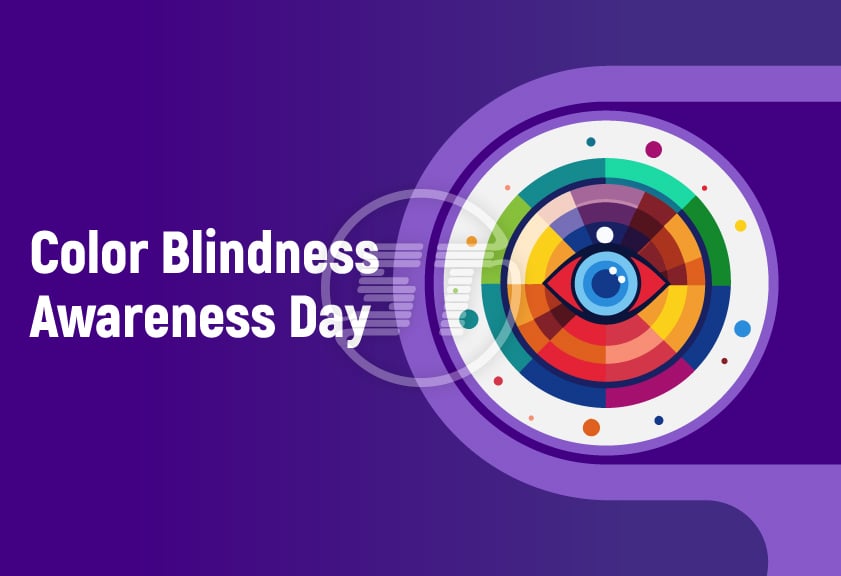Color Blindness Awareness Day is observed every year on September 6. It is a crucial reminder to consider the needs of individuals with color vision deficiency (CVD) in digital design and accessibility. Approximately 8% of men and 0.5% of women globally are affected by some form of color blindness, which makes navigating the digital world challenging when designs rely heavily on color cues.
As digital spaces continue to grow and evolve, it is essential to raise awareness and implement strategies that enhance digital accessibility for color-blind users.
Color blindness – summary!
Color blindness is a condition where someone has difficulty distinguishing between certain colors. The most common types include:
- Protanopia – struggle in distinguishing between red and green hues due to the malfunction or absence of red cone cells in some individuals.
- Deuteranopia – difficulty in distinguishing green and red colors because either green cone cells are absent or malfunctioning in those individuals.
- Tritanopia – difficulty in distinguishing between blue and yellow colors due to the malfunction or absence of blue cone cells.
- Monochromacy – A rare condition in which individuals can only see shades of grey.
Digital designs that rely heavily on color differentiation can pose significant challenges to users with these types of color vision deficiencies. For instance, a green colored “Submit” button might be indistinguishable from some other button (let’s say, “Cancel”) for a person with green-red color blindness or Deuteranopia.
History of color blindness awareness day!
John Dalton, a scientist, was suffering from color blindness disease and was born on September 6, 1766. Apparently, he was the first person to recognize color blindness. Neither he nor his brother could see colors the same way others used to see. Though back then in 1766, it was not a known problem. But 150 years later, science and his DNA proved that Mr. Dalton inherited the issue.
Thereby in his memory, color blindness awareness day was chosen to celebrate every year on September 6.
The idea of celebrating this uniqueness of several individuals began in 2015 and with each passing year, more and more people are recognizing and participating in this event.
Many organizations promote color blindness by organizing various activities. One of the noticeable activities to raise awareness digitally is focusing on social media campaigns. Businesses that are keen to be inclusive should plan online activities on color blindness to attract and engage more users suffering from color blindness. Also, they must focus on embedding changes across the digital products and services based on web accessibility requirements to ensure their accessibility for everyone.
Practices to enhance the accessibility of the digital world for color-blind users!
Use textures and patterns, not just colors
Textures and patterns help differentiate between elements without relying solely on color. For instance, pie charts or graphs can use patterns (like stripes or dots) instead of or alongside colors to understand various sections.
Moreover, color should not be the only way to convey important information. For example, a website indicating error messages only by red text is a wrong practice. Instead, they must include icons, bold text, or other visual cues to highlight errors.
Ensure sufficient contrast
Poor contrast between text and background colors can be particularly challenging for color-blind users. Ensuring a high contrast ratio significantly improves readability, for instance, black text on a white background. WCAG recommends a minimum contrast ratio of 4.5:1 for normal text and 3:1 for large text.
Provide color blindness-friendly palettes
When designing websites and applications, use color blindness-friendly palettes. Tools like Color Oracle, ColorBrewer, and Coblis simulate how color-blind users perceive a web design, allowing designers to adjust accordingly.
Include alternative text descriptions
Providing descriptive text for visual elements like graphs, charts, and images can help users understand the content without relying on color differentiation. These descriptions should be clear and provide essential information conveyed by the visuals.
Test with color-blind simulators
Simulating color blindness with tools like Chrome’s Colorblinding extension can help designers understand how their designs will appear to color-blind users. Testing regularly ensures that designs remain accessible throughout updates.
Provide training to stakeholders
Digital accessibility requires a cultural shift. Designers, developers, and content creators must be educated on the importance of accessibility for color-blind users. Raising awareness through training sessions, workshops, and awareness campaigns is vital.
Are you aware of how your website looks to users with color blindness?
Experience it firsthand with our Color Blindness Simulator and see how your website’s design can be optimized for inclusivity. By understanding the challenges colorblind users face, you can improve accessibility and reach a wider audience.
Provide accessible digital spaces to color blind users by filling balanced colors to websites/applications!
Color blindness awareness day serves as an important reminder to take proactive steps toward enhancing digital accessibility. By considering the needs of color-blind users and implementing thoughtful design strategies, organizations can ensure a more inclusive digital world for everyone.
Prioritize digital accessibility on every day not only on awareness day!
Tools or third-party software to improve accessibility in websites for color-blind users!
The best web practices are always suggested to adhere to in order to offer accessible websites to color-blind users. Besides, there are third-party widgets / extensions / software that help bring accessibility in just a few clicks.
All in One Accessibility has several features to achieve accessibility goals for various disabilities and one of the features is including color blindness. Ensure your website is accessible to everyone, including those with color blindness.
The color blindness feature helps users to change web page colors setting according to their color blindness deficiency. The widget covers various color blindness settings such as:
- Protanomaly
- Deuteranomaly
- Tritanomaly
- Protanopia
- Deuteranopia
- Tritanopia
- Achromatomaly
- Achromatopsia
This feature is available with the paid version of the All in One Accessibility widget. To learn more about the color blindness feature and other features as well, go to its feature page.
Don’t forget to use our free WCAG web accessibility color contrast checker to check your website's color combinations against WCAG A, AA, and AAA requirements.


